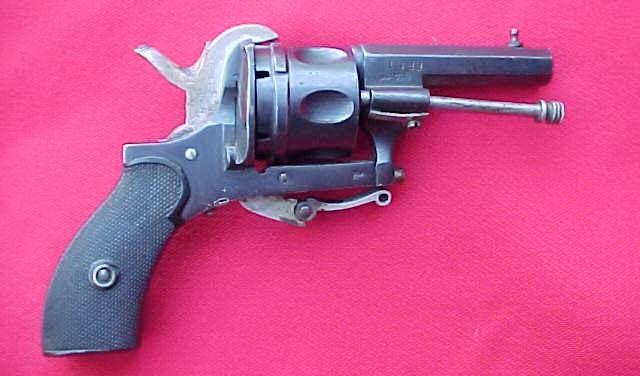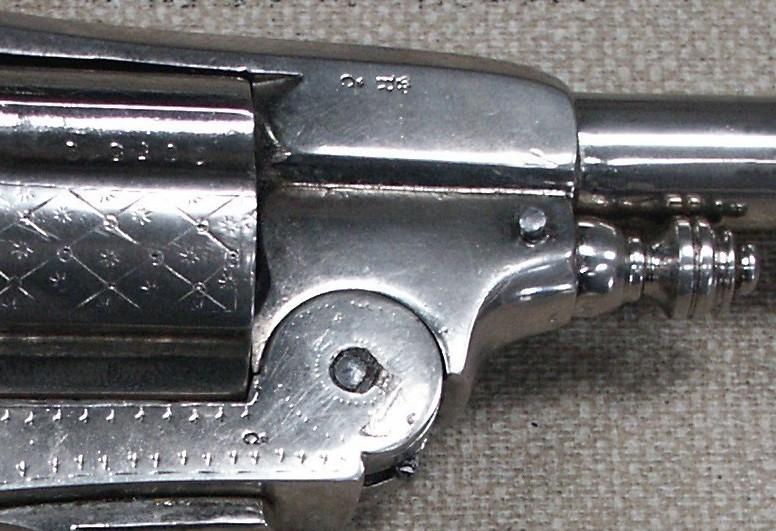Some of the most beautiful work of this craftsman, and many others, are in this book “Liège Gunmakers through their Work. 1800 - 1950”.
For more detail see: LIEGE GUNMAKERS
FLIEGENSCHMIDT Max
Here is a copy of a .320 S&W five-shot revolver made
by Max FLIEGENSCHMIDT's
company, already extensively mentioned on the littlegun site, both among the
identified artisans and in the exceptional collection. Photos of an identical
model can be found on the site.
It is also marked
MF and
surmounted by a crown, one of the
trademarks registered by
Max FLIEGENSCHMIDT
on November 19, 1891.
Markings
ELG on
star in crowned oval: accepted by the Liège Test Bench, in use from 11 July
1893;
y under
asterisk (three times): countermark of a controller, in use since 1877.
According
to two members of the team, it is therefore a copy of the very common S&W .32
DA, which is divided into five variations of detail, here probably the third
variation. Manufactured from 1880 to 1919 in tens of thousands, also in .38 S&W
calibre. Note that the very first version - 1880 - was produced in only 30
copies and that it is priced at $ 10,000 in the Flayderman and the Blue Book.
Subsequently, prices fall. The third variation is quoted only $325.
The
absence of a visiting hatch on the left flank and the two pins under the dog's
axle confirm that the Liège copy has the same trigger mechanism as the BullDogs,
much simpler than the S&W tumbler mechanism, and therefore cheaper while
offering the same efficiency. These copies (in .320 and .380 in our country)
must have been very popular also around the turn of the century, before the
invasion of Browning pistols.
GP, MC and AR.












FLIEGENSCHMIDT Max
Here is a Belgian-made revolver marked
MF crowned
for Max
Fliegenschmidt, registered trademark in
1891. He was enrolled in the proofhouse of Liège between 1888 and 1908.
It has a vague family look with the French
Chamelot-Delvigne 1873 revolver, but of course it also has the “Mauser type”
security on the left, typical of most of
Max
Fliegenschmidt’s manufactures.
It also has a push button on the left side which should probably release the barrel axis. There is an air of resemblance to patent 082 870 filed by Max Fliegenschmidt on August 11, 1888. But given:
1° that the other parts of the patent are not present on the copy submitted
2° that the mention “Patent” does not appear
3°
finally, since I do not have the patience to decipher and transcribe the entire
patent in order to know whether the pushbutton actually falls within the patent,
I leave that care to those who are entitled to it.
The calibre – or at least the diameter of the barrel/cannon – is therefore not known. Probably an 11mm/450.
I see an
ELG on star in
crowned oval, for acceptance between 1893
and 1968.
I also think I see on the barrel an L under star, so the countermark of a controller between 1877 and 1968. There’s another punch, but I can’t decipher it. Probably from another controller.
I think I also see on the barrel and frame a
crowned R
for the barrels rifled between 1894 and 1968.
GP





Fliegenschmidt Max
Revolver
(Top Break) top break of the type S&W to central percussion. The cylinder is
with five shots of unspecified gauge and not communicated. The barrel is round.
It carries his round front sight far from the mouth, this to possibly make it
possible to recut this one to facilitate the setting out of pocket. The trigger
without trigger guard is slightly curved and is folded back under the breech.
The opening (crack) of the weapon is practiced using the double squared button
placed in top of the breech and to draw upwards. The hammer of the hammerless
type is dissimulated in the carcass. The grips are out of ebony or false-ebony
and maintained by a central screw.
The
weapon carries the lawful punches of the profhouse of Liège, that is to say:
ELG* in
a vertical oval:
final acceptance, of use of 1846 to 1893.
J*:
countermark of the controller, of use of 1877 to 1968.
A figure 2
seem-you it, partially unobtrusive which could be the classification of the
weapon.
The
weapon also carries the following marks:
M F
crowned:
mark manufacturing
Fliegenschmidt Max,
street of the Fish pond, 30 in Liège. He was registered with the proofhouse of
1888 to 1908. He was titular of a patent d' for improvements with the revolvers
and of 3 trademarks.
N.
LEDENT:
mark of the subcontractor
Noël LEDENT of
Liège-Barchon. It was titular of a patent gone back to 1886 and bearing on a
stop of striker applicable to the revolvers.
GG









Max FLIEGENSCHMIDT
Here is a classic revolver known as Montenegrin from the factory of Max Fliegenschmidt in Liege. He had better days, a long time ago of course. But what is very rare is the case that comes with it. Too bad there's no picture of the whole gun on the left side. The caliber appears to be 11 mm.
I don't have much to add to what is already on the website.
So this
is the long barrel version.
The
weapon is former to 1893 since the punch of acceptance ELG on star in an oval is
not crowned.
We also
see a "NI" in front of the sights, for Nikita I, the king of Montenegro who
obliged his male subjects to have a revolver.....
See also
:
GP and HPH









Max FLIEGENSCHMIDT
It acts of a revolver bulldog kind for Germany or Austria because of its safety on the carcass on the left-hand side.
The weapon is with central percussion calibre .32 to six blows of them.
It was manufactured by the arms manufacturer inhabitant of Liège FLIEGENSCHMIDT Max (bench of test 1888/1908) Rue du vivier, 30 in Liege.
The interested party deposited a patent for improvements brought to the revolvers.
He also deposited three trademarks the 19.11.1891 is:
- crowned MF
- a crossed apple of an arrow and mention S.MARKE
- IT TERRIBILE
In 1908, its activity was taken again by FRANKEN & LUNNENSCHLOOS.
GG



Another revolver signed by Max Fliegenschmidt
Calibre 7mm pinfire








Max FLIEGENSCHMIDT
Thank to "TBERT" for the photos.
Max FLIEGENSCHMIDT
Photos Littlegun

Montenegrin revolver of Max Fliegenschmidt
Photos Littlegun



Mark SCW!!
"SCW", the mystery does not exist any more. "SCHUTZMARKE" (= Trade mark), it is a part of the marking of the proper revolvers of the Austrian firm Gasser. On the Belgian copies the first three letters are not given like "SCH" but like "SCW". In this connection, the apple bored by an arrow (of Gasser origin) by a heart with an arrow, isn't this was replaced?
Please find annexed the marking of a truth Gasser ("L G." = Léopold Gasser) have bored apple and word "SCHUTZMARKE" (= trade mark).
DZ (Germany)


An apple crossed by an arrow with the top of "S. MARKE" in half-circle: mark deposited by Max Fliegenschmidt, street of the Fish pond, 30, Liege the 19/11/1891
Phil (Belgium)
After having thrown a glance with the explanations of DZ concerning revolver SCW, here what I can say moreover:
For marking "SCHUTZ MARKE" I agree.
For that on the top it is marked "GUSS STAHL PATENT"
Montenegrin Gasser-style revolvers, however, were made by numerous small Belgian and Austrian firms, as well as by Leopold Gasser. Later models offered hinged-frame construction, with Galand cylinder locks and a self-extracting mechanism. Most are marked 'Guss Stahl', 'Kaiser's Patent' and similar phrases. Genuine Gasser products are marked 'L. GASSER PATENT WIEN' or 'L. GASSER OTTAKRING PATENT', and often carry the Gasser trademark of a heart pierced by an arrow. Gasser also produced revolvers for the commercial market.
German makers were fond of indicating the type of steel in their barrels, a practice that continued up until about WW2. In the 1840s, most barrels were still made from iron, not steel. "Guss Stahl" undoubtedly indicates that the barrel is made from a specific type of steel, but I do not know what type. Metallurgy was in its infancy then, and designations for various types of steel were not at all uniform, nor were the chemical or physical properties of any of the various types.
Herewith does a photograph of a revolver "Vero Montenegrin Guss Stahl Patent Double Action Service Revolver, 44 centerfire caliber" where one can read markings correctly, the drawing (arrow + heart-apple??) with the top of "SCHUTZ MARKE" seems also identical.
Friendly,
Roger (France)


A small word on the "Revolvers Montenegrins"
The hinged-frame action was design of Belgian firearms manufacturer Jean Warnant and his assistant Fransquet, but the twin-latch opening was designed by Philippe Counet of Belgian Auguste Francotte's plant. Design of Warnant & Fransquet had just one opening lever on the right or left side of frame.
11 mm Montenegrin Gasser revolvers were heavy and big, usually with twin-latch hinged frame. (Opening levers on both sides of the frame; Counet's design).
Montenegrin King Nikita (or Nicolas; reign 1910 - 18) was a notable shareholder of a firm Leopold Gasser and an efficient salesman of old-fashioned revolvers, already before his royal reign. King Nikita declared a famous Royal Act: "Every male citizen of Montenegro is a member of the Militia, and therefore not only justified but also obliged to possess at least one Gasser Pattern revolver."
Montenegrins models were designed in 1880, both solid-frame and hinged-frame versions, caliber usually 11 mm, but after declaration of Royal Act the 9 mm G-K models became also popular, since the teen-ager or still younger boys got the right (and obligation) to acquire, possess and carry a revolver.
Population of Montenegro was considerably less than half million citizens in 1910, but some patriotic (= wealthy) Montenegrins acquired as many as a dozen Gasser wheel guns.
Huge orders of obsolete Montenegrin revolvers kept the firm Leopold Gasser alive until the end of First World War, although Austro-Hungarian armed forces did no more order 8 mm Rast-Gasser revolvers after adoptment of self-loading 9 mm Steyr-Hahn pistols since 1912.
Less wealthy citizens of Montenegrins Kingdom acquired cheap Belgian look-alikes of Montenegrin Gasser revolvers, including Warnant's Montenegrin models, because the Royal Act mentioned Gasser as a pattern of revolver but not as an actual manufacturer of it."
Original Gasser Montenegrins revolver Model 1880 with hinged frame and Gounot's twin-latch. Caliber 11,3 mm Gasser. Optional barrel lengths were either 133 mm or 235 mm. Co-designer or this model, Archduke Nikita (later King) of Montenegro, preferred "Buntline Special" barrel with a length 235 mm.